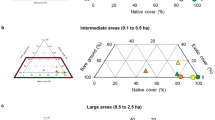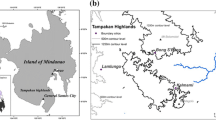Abstract
The impact of disturbance on species diversity may be related to the spatial scales over which it occurs. Here I assess the impact of logging and ENSO (El Niño Southern Oscillation) -induced burning and forest isolation on the species richness (477 species out of more than 28,000 individuals) and community composition of butterflies and butterfly guilds using small (0.9 ha) plots nested within large (450 ha) landscapes. The landscapes were located in three habitat classes: (1) continuous, unburned forest; (2) unburned isolates surrounded by burned forest; and (3) burned forest. Plots with different logging histories were sampled within the two unburned habitat classes, allowing for independent assessment of the two disturbance factors (logging and burning). Disturbance within habitat classes (logging) had a very different impact on butterfly diversity than disturbance among habitat classes (due to ENSO-induced burning and isolation). Logging increased species richness, increased evenness, and lowered dominance. Among guilds based on larval food plants, the species richness of tree and herb specialists was higher in logged areas but their abundance was lower. Both generalist species richness and abundance was higher in logged areas. Among habitat classes, species richness was lower in burned forest and isolates than continuous forest but there was no overall difference in evenness or dominance. Among guilds, generalist species richness was significantly lower in burned forest and isolates than continuous forest. Generalist abundance was also very low in the isolates. There was no difference among disturbance classes in herb specialist species richness but abundance was significantly higher in the isolates and burned forest than in continuous forest. Tree specialist species richness was lower in burned forest than continuous forest but did not differ between continuous forest and isolates.
The scale of assessment proved important in estimating the impact of disturbance on species richness. Within disturbance classes, the difference in species richness between primary and logged forest was more pronounced at the smaller spatial scale. Among disturbance classes, the difference in species richness between continuous forest and isolates or burned forest was more pronounced at the larger spatial scale. The lower levels of species richness in ENSO-affected areas and at the larger (landscape) spatial scale indicate that future severe ENSO events may prove one of the most serious threats to extant biodiversity.





Similar content being viewed by others
References
Andersen AN (1999) Using ants as bioindicators: multiscale issues in ant community ecology. Conserv Ecol 1:1–13
Asdak C, Jarvis PG, Van Gardingen P, Fraser A (1998) Rainfall interception loss in unlogged and logged forest areas of Central Kalimantan, Indonesia. J Hydrol 206:237–244
Bennet EL (2000) Timber certification: where is the voice of the biologist? Conserv Biol 14:921–923
Blair RB (1999) Birds and butterflies along an urban gradient: surrogate taxa for assessing biodiversity. Ecol Appl 9:164–170
Bray JR, Curtis JT (1957) An ordination of the upland forest communities of Southern Wisconsin. Ecol Monogr 27:325–349
Brown JH, Whitman TG, Morgan Ernest SK, Gehring CA (2001) Complex species interactions and the dynamics of ecological systems: long-term experiments. Science 293:643–650
Cannon CH, Peart DR, Leighton M (1998) Tree species diversity in commercially logged Bornean rainforest. Science 281:1366–1368
Casagrandi R, Gatto M (1999) A mesoscale approach to extinction risk in fragmented habitats. Nature 400:560–562
Caswell H (1976) Community structure: a neutral model analysis. Ecol Monogr 46:327–354
Chase JM, Leibold MA (2002) Spatial scale dictates the productivity-biodiversity relationship. Nature 416:427–430
Clarke KR, Gorley RN (2001) Primer v5: user manual/tutorial. Primer-E, Plymouth
Connell JH (1978) Diversity in tropical rain forests and coral reefs. Science 199:1304–1310
Corbet AS, Pendlebury HM (1992) The butterflies of the Malay peninsula. Malayan Nature Society, Malaysia
Danielsen F, Heegaard M (1995) Impact of logging and plantation development on species diversity, a case study from Sumatra. In: Sandbuht Ø (ed) Management of tropical forests, towards an integrated perspective. Centre for Development and the Environment, University of Oslo, pp 73–92
Davies RG (1997) Termite species richness in fire-prone and fire-protected dry deciduous dipterocarp forest in Doi Suthep-Pui National Park, northern Thailand. J Trop Ecol 13:153–160
Dennis RLH (1993) Butterflies and climate change. Manchester University Press, Manchester
Fiedler K (1991) Systematic, evolutionary, and ecological implications within the Lycaenidae (Insecta: Lepidoptera: Papilionoidea). Bonn Zool Monograf 31:1–210
Fuller RM, Groom GB, Mugisha P, Ipulet P, Pomeroy D, Katende A, Bailey R, Ogutu-Ohwayo R (1998) The integration of field survey and remote sensing for biodiversity assessment: a case study in the tropical forests and wetlands of Sango Bay, Uganda. Biol Conserv 86:379–391
Gardette E (1998) The effect of selective timber logging on the diversity of woody climbers at Pasoh. In: Lee SS, May YM, Gould ID, Bishop J (eds) Conservation, management, and development of forest resources. Forest Research Institute, Malaysia, Kepong, pp 115–126
Gotelli NJ, Colwell RK (2001) Quantifying biodiversity: procedures and pitfalls in the measurement and comparison of species richness. Ecol Lett 4:379–391
Gotelli NJ, Entsminger GL (2001) EcoSim: null models software for ecology. Version 6.0. Acquired Intelligence Inc. and Kesey-Bear, http://homepages.together.net/~gentsmin/ecosim.html. Cited April 2002
Gutzwiller KJ, Barrow Jr WC (2002) Does bird community structure vary with landscape patchiness? A Chihuahuan desert perspective? Oikos 98:284–298
Hamer KC, Hill JK (2000) Scale-dependent effects of habitat disturbance on species richness in tropical forests. Conserv Biol 14:1435–1440
Harrison RD (2000) Repercussions of El Niño, drought causes extinction and the breakdown of mutualism in Borneo. Proc R Soc Lond B Biol Sci 267:911–915
Heydon MJ, Bulloh P (1997) Mousedeer densities in a tropical rainforest: the impact of selective logging. J Appl Ecol 34:484-496
Hill JK, Hamer KC, Tangah J, Dawood M (2001) Ecology of tropical butterflies in rainforest gaps. Oecologia 128:294–302
Hoffmann AA, Hinrichs A, Siegert F (1999) Fire damage in East Kalimantan in1997–1998 related to land use and vegetation classes: satellite radar inventory results and proposals for further actions. IFFM/SFMP Report No. 1a
Holdsworth AR, Uhl C (1997) Fire in Amazonian selectively logged rain forest and the potential for fire reduction. Ecol Appl 7:713–725
Holmgren M, Scheffer M, Ezcurra E, Gutierrez JR, Mohren GMJ (2001) El Niño effects on the dynamics of terrestrial ecosystems. Trends Ecol Evol 16:89–94
Howard PC, Viskanic P, Davenport TRB, Kigenyi FW, Baltzer M, Dickinson CJ, Lwanga JS, Matthews RA, Balmford A (1998). Complementarity and the use of indicator groups for reserve selection in Uganda. Nature 394:472–475
Hurlbert SH (1971) The nonconcept of species diversity: a critique and alternative parameters. Ecology 52:577–585
Janz N, Nylin S (1998) Butterflies and plants: a phylogenetic study. Evolution 52:486–502
Johns AD (1992) Vertebrate responses to selective logging: implications for the design of logging systems. Philos Trans R Soc Lond B Biol Sci 335:437–442
Johns AG (1996) Bird population persistence in Sahaban logging concessions. Biol Conserv 75:3–10
Laurance WF, Didham RK, Power ME (2001a) Ecological boundaries: a search for synthesis. Trends Ecol Evol 16:70–71
Laurance WF, Pérez-Salicrup D, Delamônica P, Fearnside PM, D'Angelo S, Jerozolinski A, Pohl L, Lovejoy TE (2001b) Rain forest fragmentation and the structure of Amazonian liana communities. Ecology 82:105–116
Lewis OT (2001) Effect of experimental selective logging on tropical butterflies. Conserv Biol 15:389–400
Mackey RL, Currie DJ (2000) A re-examination of the expected effects of disturbance on diversity. Oikos 88:483–493
Malcolm JR, Ray JC (2000) Influence of timber extraction routes on Central African small-mammal communities, forest structure, and tree diversity. Conserv Biol 14:1623–1638
Maruyama K, Otsuka K (1991) Butterflies of Borneo, vol 2, no 2. Tobishima Corporation, Tokyo Japan
McCabe DJ, Gotelli NJ (2000) Effects of disturbance frequency, intensity and area on assemblages of stream macroinvertebrates. Oecologia 124:270–279
Morris DW (1996) Coexistence of specialist and generalist rodents via habitat selection. Ecology 77:2352–2364
Nyström M, Folke C, Moberg F (2000) Coral reef disturbance and resilience in a human-dominated environment. Trends Ecol Evol 15:413–417
Oksanen L (2001) Logic of experiments in ecology: is pseudoreplication a pseudoissue? Oikos 94:27–38
Otsuka K (1988) Butterflies of Borneo, vol 1. Tobishima Corporation, Tokyo
Parmesan C, Ryrholm N, Stefanescu C, Hill JK, Thomas CD, Descimon H, Huntley B, Kaila L, Kullberg J, Tammaru T et al (1999) Poleward shifts in geographical ranges of butterfly species associated with regional warming. Nature 399:579–583
Parson KE (1998) The role of dispersal ability in the phenotypic differentiation and plasticity of two marine gastropods. II. Growth. J Exp Mar Biol Ecol 221:1–25
Pearman PB (1997) Correlates of amphibian diversity in an altered landscape of Amazonian Ecuador. Conserv Biol 11:1211–1225
Rozenzweig ML (1995) Species diversity in space and time. Cambridge University Press, Cambridge
Scheiner SM (1998) The genetics of phenotypic plasticity. VII. Evolution in a spatially-structured environment. J Evol Biol 11:303–320
Schnitzer SA, Bongers F (2002) The ecology of lianas and their role in forests. Trends Ecol Evol 17:223–230
Seki Y, Takanami Y, Maruyama K (1991) Butterflies of Borneo, vol 2: Lycaenidae. Tobishima Corporation, Tokyo
Siegert F, Ruecker G, Hinrichs A, Hoffmann AA (2001) Increased damage from fires in logged forests during droughts caused by El Niño. Nature 414:437–440
Slik JWF, Verburg RW, Kessler PJA (2002) Effects of fire and selective logging on the tree species composition of lowland dipterocarp forest in East Kalimantan, Indonesia. Biodivers Conserv 11:85–98
Spitzer K, Jaros J, Havelka J, Leps J (1997) Effect of small-scale disturbance on butterfly communities of an Indochinese montane rainforest. Biol Conserv 80:9–15
Statistica for Windows (1996) Version 5.0. Statsoft Inc. Tulsa, Okla
Suguru I, Haruo F (1997) The life histories of Asian butterflies, vol 1. Tokai University Press
Suguru I, Haruo F (2000) The life histories of Asian butterflies, vol 2. Tokai University Press
Summerville KS, Crist TO (2002) Effects of timber harvest on forest lepidoptera: community, guild, and species responses. Ecol Appl 12:820–835
Thiollay JM (1992) Influence of selective logging on bird species diversity in a Guianan rain forest. Conserv Biol 6:47–63
Thiollay JM (1997) Disturbance, selective logging and bird diversity, a Neotropical forest study. Biodivers Conserv 6:1155–1173
Tudhope AW, Chilcott CP, McCulloch MT, Cook ER, Chappell J, Ellam RM, Lea DW, Lough JM, Shimmield GB (2001) Variability in the El Niño Southern Oscillation through a glacial-interglacial cycle. Science 291:1511–1517
Van Nieuwstadt MGL, Sheil D, Kartawinata K (2001) The ecological consequences of logging in the burned forests of East Kalimantan, Indonesia. Conserv Biol 15:1183–1186
Vasconcelos HL, Vilhena JMS, Caliri GJA (2000) Responses of ants to selective logging of a central Amazonian forest. J Appl Ecol 37:508–514
Walpole MJ, Sheldon IR (1999) Samplings butterflies in tropical rainforest, an evaluation of a transect walk method. Biol Conserv 87:85–91
Whitmore TC (1997) Tropical forest disturbance, disappearance, and species loss. In: Laurance WF, Bierregaard RO (eds) Tropical forest remnants: ecology, management, and conservation of fragmented communities. University of Chicago Press, Chicago, pp 3–12
Willott SJ, Lim DC, Compton SG, Sutton SL (2000) Effects of selective logging on the butterflies of a Bornean rainforest. Conserv Biol 14:1055–1065
Wolda H (1981) Similarity indices, sample size and diversity. Oecologia 50:296–302
Woods P (1989) Effects of logging, drought, and fire on structure and composition of tropical forests in Sabah, Malaysia. Biotropica 21:290–298
Yamakura T, Hagihara A, Sukardjo S, Ogawa H (1986) Aboveground biomass of tropical rainforest stands in Indonesian Borneo. Vegetatio 68:71–82
Acknowledgements
All field assistants in Kalimantan are thanked for their help. D. Wielakker, A. Bijlmer, Y. Pitoy, M. Buntu, A. Pakala, I. Sharif, B. van Helvoort, T. de Kam, W. Smits, M. Oman, N. Boestani, K. Eichhorn, L. Eichhorn, L. du Pon and Pak Bambang (ITCI) all provided valuable help in Indonesia. R. de Jong and H. Megens assisted with species identification. E. Michel and S. Menken and two anonymous reviewers provided valuable comments on an earlier version of this article. J. van Arkel provided help with the layout of the figures. The Indonesian Ministry of Forestry and Crop Estates, the Kayu Mas concession and ITCI concession provided field facilities. This study was supported by grant 895.100.005 from the Dutch Science Foundation (NWO), within the Priority Programme 'Biodiversity in Disturbed Ecosystems'.
Author information
Authors and Affiliations
Corresponding author
Rights and permissions
About this article
Cite this article
Cleary, D.F. An examination of scale of assessment, logging and ENSO-induced fires on butterfly diversity in Borneo. Oecologia 135, 313–321 (2003). https://doi.org/10.1007/s00442-003-1188-5
Received:
Accepted:
Published:
Issue Date:
DOI: https://doi.org/10.1007/s00442-003-1188-5




